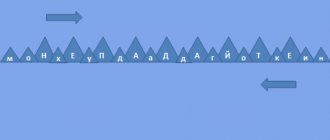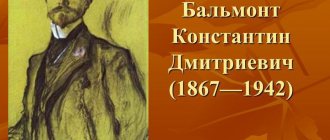Literature lesson based on the work of I. S. Turgenev “Biryuk” (2 hours) for grade 7
Category: Literature.
Literature lesson based on the work of I. S. Turgenev “Biryuk” (2 hours) for grade 7
1 lesson.
Lesson topic: Turgenev’s childhood and youth, the history of the creation of the collection “Notes of a Hunter”
Lesson type: lesson - presentation
The purpose of the lesson: to acquaint students with the childhood and youth of I. S. Turgenev, with the history of the creation of the collection “Notes of a Hunter”, with Turgenev’s story “Biryuk”
Objectives of the lesson: to develop interest in Turgenev’s work, learn to analyze text, answer questions, improve oral speech, and develop creative abilities.
Equipment: portrait of Turgenev, computer, interactive board
During the classes:
1) Organizational moment. Greetings, get ready for the lesson
2) The teacher’s story about Turgenev’s childhood and youth
I. S. Turgenev was born in 1818 into a noble family. The writer's childhood years were spent on his mother's estate Spasskoye - Lutovinovo, Oryol province. The relationship between the parents was difficult, and this was reflected in the impressionable boy.
Turgenev’s father, Sergei Nikolaevich, married for the sole purpose of improving his financial situation.
Mother, Varvara Petrovna, was a cruel and capricious woman who took out her grievances on those around her. Little Turgenev loved to leave home, walk around Spassky Garden, and communicate with people from among the people. I. S. Turgenev’s parents understood the need for education, and therefore, from childhood, he spoke three foreign languages: German, English, French; read a lot; took part in theatrical performances that were held on the estate.
In 1837, I. S. Turgenev successfully graduated from the Faculty of Philosophy of St. Petersburg University. To continue his education, Ivan Sergeevich goes to the University of Berlin. Returning to Russia and trying his hand at public service, in 1845 I. S. Turgenev decided to devote himself entirely to literary activity, and in 1847 his first serious literary work was published - the first stories from the future collection “Notes of a Hunter.”
3) Analysis of the textbook article
Reading an article in a textbook and discussing the following questions:
1. 1. What did hunting trips give Turgenev as a writer? (hunting brought Turgenev together with different people, he studied folk life and folk souls)
1. 2. What did Turgenev discover in a peasant? (mind, rich inner world, on the one hand. On the other hand, it showed the man’s complete lack of rights)
1. 3. What was the important social significance of the book “Notes of a Hunter”? (“a real chronicle of Russian life and Russian people”)
1. 4. Why do you think the two peasants thanked the writer?
4) Commented reading of the story “Biryuk”
5) Homework: read the story “Biryuk”, prepare a story about the history of the creation of hunters’ notes
Lesson 2.
Lesson type: Lesson on learning new things.
Lesson topic: I. S. Turgenev “Biryuk”
The purpose of the lesson: to introduce students to the problems of Turgenev’s story “Biryuk”, to introduce the concept of conflict.
Lesson objectives: teach to analyze a text, characterize a character, draw conclusions, generalizations, help improve students’ oral speech, and develop creative abilities.
During the classes:
Organizing time. Greetings, get ready for the lesson
1) Checking homework, students’ story about the work of I. S. Turgenev and the history of the creation of “Notes of a Hunter”
2) Review questions:
– What goal did Turgenev pursue when creating “Notes of a Hunter”? (show the peasant’s originality and talent)
– What unites all the stories in the collection? (image of the narrator, general goal)
– Who is the main character in “Notes of a Hunter”? (people from the popular environment who have not lost their self-esteem)
3) Introducing students to the story “Biryuk”, discussing the issues.
– How did this story make you feel?
– Name the main characters of the story. (narrator, Biryuk, man).
– What role does the landscape play in the work? reading a passage (the landscape is not only a backdrop for the development of the action of the work, but also helps to reveal the lifestyle, character, and mood of the main characters).
– What hero appears unexpectedly with a flash of lightning? (Biryuk)
– What does the author want to say about the hero who appears in the flash of lightning? (the author notes his sonorous voice, tall figure, wants to emphasize the strength of the hero, showing him in contrast with the thunderstorm).
- How does Biryuk live? reading the description of the hut (very poor)
– What did the author want to say by contrasting the description of a strong, raging thunderstorm with Biryuk’s wretched hut? (the description of the forester’s hut speaks of his social status, and the artistic portrait helps to see individual features: a courageous face, powerful muscles, tall stature. In the reader’s perception, the story about the forester as a thunderstorm for men is associated with the picture of a thunderstorm)
– Why did the peasants nickname the forester Biryuk? (for unsociable character)
let's look at the dictionary
– What conflict lies at the heart of the work?
The concept of conflict. Definition in a notebook.
Conflict-clash, serious disagreement (S. I. Ozhegov)
The participants in the conflict are Biryuk and the man.
– Write a short story about the participants in the conflict. (Option I – Biryuk’s characteristics, option II – characteristics of a man) The guys read out their characteristics.
– What caused the man’s anger and hatred towards Biryuk? (despair)
– Explain the meaning of the ending of the story. Why do you think Biryuk let the guy go? (felt sorry for the man)
– Which of the heroes, in your opinion, stands on a higher moral position? Why? (Biryuk stands on a higher moral position: despite the fact that he is as poor as a peasant, he cannot go against his principles: steal, take bribes, etc.)
4) Summing up:
– What is the main idea of this work?
In Biryuk's story, the author touches on the issue of peasant protest. The image of Biryuk is a tragic image: an honest, stern man, imbued with the principle of serving duty, but still he feels the rightness of the peasant, whom a miserable existence brought to the forest. The author very accurately conveys the mental conflict between duty and compassion.
5) Homework: Read poems in prose by I. S. Turgenev.
Yu. V. Klimkina, Lyceum 590, St. Petersburg
Tags: Literature
- Back
- Forward
Lesson summary based on I. Turgenev’s story “Biryuk”
Literature lesson
“The Russian national character of the hero in the story by I.S. Turgenev "Biryuk"
7th grade
Ryauzova I.N.
The purpose of the lesson:
creating conditions for students’ communicative competence during text analysis
Tasks:
- expand students’ knowledge about the personality and views of I.S. Turgenev;
- deepen the concept of Russian national character;
- improve characterization skills and expressive reading skills;
- the ability to determine the author’s position, formulate one’s own point of view, and argue for it;
- develop monologue speech skills;
- the ability to analyze a literary work, a separate episode.
Lesson type:
lesson in the formation and improvement of knowledge.
Equipment:
presentation (slides), V.I. Dahl's dictionary, textbooks for grade 7, ed. V.Ya.Korovina, art. film "Biryuk", studio named after. A. Dovzhenko, 1977
Teacher's word:
Slide 1 (portrait of I.S. Turgenev)
Ivan Sergeevich Turgenev was one of the leading people of his time. He realized that in order to win the right to be called a people's writer, talent alone is not enough, you need “sympathy for the people, a kindred disposition towards them” and “the ability to be imbued with the essence of your people, their language, their way of life.” In the collection “Notes of a Hunter,” the peasant world is described very vividly and multifacetedly. "Notes of a Hunter" was published in 1852. They were a profound expression of the social struggle against serfdom, at the center of which was the fate of the serf peasantry of the 19th century. Even in his youth, the future writer took an oath to fight the national enemy. “In my eyes,” wrote Turgenev, “this enemy had a certain image, bore a certain name: this enemy was serfdom.” The people's heroes of Ivan Sergeevich are characterized by high national traits. They are thinking, sensitive individuals, doomed to be the “property” of the master. In “Notes of a Hunter” his ability to express the main problems of his time through types was fully revealed. Many of the heroes were real people; Turgenev relied on his own impressions of the life of the peasants of the Oryol province, on his mother’s estate. His stories in “Notes of a Hunter” breathe with intransigence and hatred of serfdom, which oppresses the individual. The story “Biryuk,” which we will talk about today, is also included in this collection. Let's find out what qualities of a Russian person are reflected in the story, how a person's character is manifested through a portrait description, attitude towards nature and people.
Reading a story to children.
– What is the main theme of the story? - Main thought?
Definition of story composition
- Premise (the weather begins to deteriorate, “a thunderstorm is approaching”)
- Development of the action (meeting with the forester, more rain, the path to the forester’s hut)
- Climax (after the end of the rain, Biryuk hears the sound of an ax)
- Denouement (Biryuk shouts to the man: “Get out...”)
Teacher:
What is the role of story composition? V. Belinsky described his impressions of “Notes of a Hunter” as follows: “Turgenev approached the people from a side from which no one had approached him before.” – How do you understand Belinsky’s words? – What is the secret of interest in Turgenev’s stories, in particular “Biryuk”, in your opinion? By what means of creating an image does the author help us understand the soul of a Russian person? (Landscape, interior, portrait, vocabulary).
Preparation for reading landscape sketches, their commentary
Slide 2 (thunderstorm)
Analysis of
a fragment
beginning with the words “A thunderstorm was approaching...” - What parts of speech predominate in this fragment?
(Adjectives - epithets: “huge purple cloud”, “long gray clouds”, “stifling heat”).
– What is their role?
– Which of the landscape sketches can be considered key to understanding the image of the main character? – What role does the symbolic image of a thunderstorm play? ( Slide 3) (Firstly, the thunderstorm will occur in the forester’s house, and secondly, Biryuk himself looks like a thundercloud. The main character feels in his element during a thunderstorm: with a flash of lightning, a tall, menacing figure of the forester appears, “as if he had grown out of earth." Despite the intensification of the thunderstorm (“white lightning illuminated the forester from head to toe,” “the rain poured with redoubled force”), he easily “pulled off” the frightened horse, and remains calm throughout the entire path through the storm forest. Apparently , the thunderstorm is not scary for him, he himself is similar to it.)
- How is the landscape related to the development of the action of the story?
What role does it play? (The author shows the fusion of man with nature)
Retelling the description of the hut
forester, expressive reading of passages (
Slide 4 – hut)
- What words in the description are key? (The room is low and empty, smoky. “It’s not fun to enter a peasant’s hut at night,” “a tattered sheepskin coat on the wall,” a pile of rags.”)
– What role does the description of the interior of the hut play?
(The forester’s hut makes a painful impression, poverty is visible in everything. The situation speaks of how joyless and difficult the life of the inhabitants of this hut is. The wretchedness of the home is emphasized by a splinter - “a splinter burned on the table, sadly flaring up and going out.”)
- How the description of the hut helps to understand character of the hero?
(The description sounds pain for the forced labor of the Russian peasant, everyday details help to imagine Biryuk’s poor, wretched life, evoke a feeling of compassion for his fate, life is difficult for Foma Kuzmich.)
- What are the features of Biryuk’s portrait?
Is it possible to determine the author's attitude towards the hero from the portrait? (The portrait of the forester is given through the eyes of a hunter-storyteller, under whom Turgenev himself is guessed)
Expressive reading of the description of the forester’s appearance by children (slides 5,6)
“He was tall, broad-shouldered and beautifully built. His powerful muscles bulged out from under his wet, dirty shirt. A black curly beard covered half of his stern and courageous face; Small brown eyes looked boldly from under fused wide eyebrows.” (The portrait evokes sympathy. The forester struck the narrator with his heroic appearance. We saw Biryuk as a courageous, stern, self-confident man. The hunter looks at him with “double curiosity”, since he heard about him “that all the surrounding men were afraid of him like fire” , “he won’t let a bundle of brushwood be dragged away,” “he’s strong and dexterous like a devil... and nothing can take him: neither wine, nor money; he doesn’t take any bait.”)
Find the meaning of the word “biryuk” in V.I. Dahl’s dictionary. Does Biryuk live up to his nickname?
1. Biryuk is a beast. Look like a silver wolf, like a wolf, gloomily, from under your brows, not knowing anyone. 2. A turquoise person, gloomy, unsociable.
(Biryuk is a master of his craft. We see a forester in action on a dark stormy night. He accurately navigates the night forest, has a keen ear. But the men blame him for his skill, they call him a “murderer.”)
How does a portrait help?
reveal the character of the hero?
From the description of the forester, one can understand that Foma Kuzmich is an honest, courageous, stern, strong person, not lacking in self-confidence. Beneath the stern, gloomy appearance lies a highly moral personality, capable of sensitive feelings, but doomed to be the property of the master. Biryuk is connected with nature, he is a man of the forest, so communication with the natural world gives him more than communication with the outside world. While Thomas is in the forest, he is not a lackey, not a slave. For the hero, protecting the forest means fulfilling a high moral duty. – Explain the meaning of the phraseological unit “not for fear, but for conscience”; which of the characters in the story does this phraseological unit characterize? Read the introductory article to the section on Turgenev in the textbook. What words can become a conclusion from what was said in the lesson?
Conclusion
Turgenev is a master of portrait sketches; he authentically paints pictures of people's life, without embellishing anything, feeling sympathy for the common people. Ivan Sergeevich shows the character of the hero through his attitude towards people, towards life, shows the nobility, the depth of feelings of a simple man, whose spiritual strength contradicts his slave position. The story has an anti-serfdom orientation.
Homework:
give a verbal description of the episode you would like to illustrate.
During the lesson, it is possible to watch episodes of the film “Biryuk”, filmed in 1977 at the film studio named after. A. Dovzhenko (or watching the film in the next lesson, where to continue the analysis).


